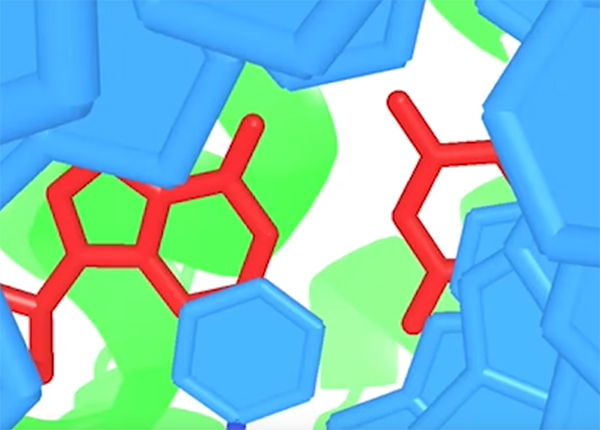Scientists in the U.S. have described how the DNA double helix contains an intrinsic timer that determines how often mutations might occur spontaneously. The team led by Ohio State University’s Zucai Suo, Ph.D., and Duke University’s Hashim M. Al-Hashimi, Ph.D., used a technique known as nuclear magnetic resonance (NMR) relaxation dispersion to recognize how the bases in a double-stranded helix of DNA undergo fleeting changes in their shape—lasting just a thousandth of a second—which allow polymerase enzymes to insert the wrong base during DNA replication. The researchers claim that these rare mismatches could underlie genetic changes that drive evolution as well as the development of diseases such as cancer.
“Increasing or decreasing the rates of spontaneous mutations could significantly alter the ability of an organism to evolve or alter its susceptibility to disease,” said Prof. Al-Hashimi, James B. Duke Professor of Biochemistry and Chemistry at the Duke University School of Medicine. “An interesting question is: What determines the mutation rate in a living organism. From there, we can begin to understand the specific conditions or environmental stressors that can elevate errors.” The researchers report their findings in Nature, in a paper entitled “Dynamic Basis for dG•dT Misincorporation via Tautomerization and Ionization.”
When cells divide, their DNA must be replicated. DNA polymerase enzymes have the job of inserting the right bases into the right positions in a new strand as it is constructred, by matching the new base pair up with its opposite number—cytosine (C) with guanine (G) and adenine (A) with thymine (T). However, this matching process isn’t infallible, and a mistake is made in roughly one in every 10,000 bases. If the error isn’t corrected, it remains fixed in place as a mutation in the new DNA.
James D. Watson and Francis H.C. Crick postulated that DNA bases can exist as alternative states, or rearrangements—known as tautomeric and anionic forms—back in 1953 when they first described the structure of the DNA double helix, the researchers write. However, scientists have also since confirmed that DNA replication is tightly controlled so that mismatches are a rarity. “In their paper describing the structure of the DNA double helix, Watson and Crick proposed that if nucleotide bases adopted their energetically unfavourable tautomeric forms, mismatches could pair up in a Watson–Crick (WC)-like geometry and potentially give rise to spontaneous mutations,” the researchers write. “Decades later, it is well established that the replicative and translational machineries have a tight control over the WC geometry to discriminate against mismatches.”
Evidence also suggests that while uncommon, tautomeric and anionic WC-like mismatches can “evade such fidelity checkpoints” and give rise to replication errors, the authors point out. To investigate this further, in 2015 the Duke team used the NMR relaxation dispersion technique to witness these shape-shifting tautomeric and anionic shape shifts in bases, which they anticipated might play “unique roles in DNA damage induction and repair, nucleic acid recognition, chemical modifications of nucleic acids, and catalysis.”
For their latest study, the researchers used an enhanced version of the technology to capture these blink-of-an-eye conformational changes in G and T and demonstrate that these “quantum jitters” happened at about the same rate as a polymerase incorporates a G-T mismatch.
The Duke University and Ohio State University researchers also fed their data into a kinetic model to track movements that led to altered states and mismatches. These results showed that tautomeric forms were more common under normal conditions, whereas anionic forms dominated in the presence of mutagens and environmental stress. The findings also indicated that the frequency at which bases shape-shifted was dependent upon on the DNA sequence. One G- and C-rich region can be associated with more incidences of shape-shifting, and so the inclusion of more mutations, than a region rich in As and Ts. “The sequence-dependent tautomerization or ionization step was inserted into a minimal kinetic mechanism for correct incorporation during replication after the initial binding of the nucleotide, leading to accurate predictions of the probability of dG•dT misincorporation across different polymerases and pH conditions and for a chemically modified nucleotide, and providing mechanisms for sequence-dependent misincorporation,” the authors state. “Our data indicate that the formation of WC-like anionic and tautomeric mismatches help to determine the frequency of dG•dT misincorporation and its dependence on pH, chemical modifications and possibly sequence.”
“In the past, we knew DNA polymerases make mistakes during DNA replication but did not know how they do it,” comments Zucai Suo, Ph.D., Ohio State professor of chemistry and biochemistry. “Now, our study provides a mechanistic sense for how the mistakes arise.” Prof. Al-Hashimi adds that, “The textbook depiction of the iconic double helix shows a static double-stranded structure, but it turns out that on rare occasions it can morph into other shapes that exist for exceptionally small periods of time. Though some might question the importance of such states, there are a growing number of studies showing they can be major drivers of biology and disease. Given the difficulty in observing these phenomena, it makes you wonder how many more states are out there dictating the outcomes of biology that we don't even know about.”
The results provide “convincing validation for the chemical origins of mutations proposed by Watson and Crick in 1953,” adds Myron Goodman, Ph.D., a professor of molecular biology and chemistry at the University of Southern California, who was not involved in the study. “It is significant scientifically, and even though it took about 65 years to prove, it also demonstrates the folly of ever betting against Watson and Crick.”
The researchers also plan to continue investigating how alternative states might be responsible for errors in other processes. “The approach presented here can be applied to examine the roles of other tautomeric and anionic mismatches in replication, transcription, translation and DNA repair,” they conclude.



